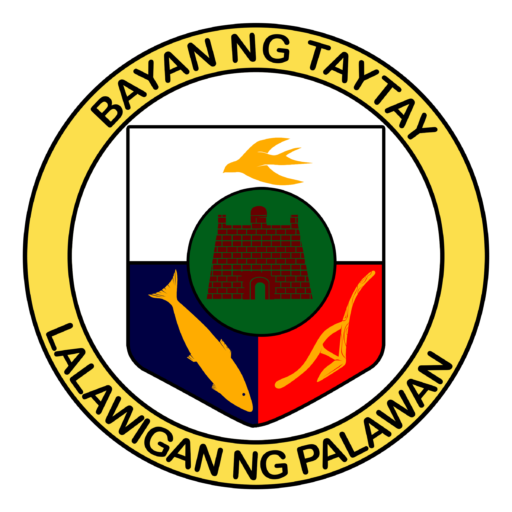People
Taytay is a first class municipality in the province of Palawan, an island of the Philippines. It has a population of about 88,000 with the Cuyuno ethno-linguistic group comprising about half of the population while the rest of the populace are a mixture of other Philippine cultural groups coming from as far as Ilocos and down to the southern islands of Mindanao, with majority of the migrants coming from the Central Visayan Islands of Panay, Negros, Cebu and nearby provinces. The municipality has 31 villages with distinct ethno-linguistic characters, making Taytay a melting pot of various Philippine cultures. Since 2002, the Cathedral of St. Joseph the Worker is the episcopal see of the pre-diocesan missionary Apostolic Vicariate of Taytay.
Brief History
Before the Spanish colonization, Taytay was inhabited by the members of the Tagbanua Tribe, who lived peacefully along the coastal areas of the present day town, particularly in Pancol, in Malampaya Sound including those in Banbanan and Liminangcong. Tagbanua settlements were also located in the island barangays of Beton, Casian, Depla, Maytegued, and Batas, as well as in the mainland barangays of Pularaquen (Canique), Pamantolon, Busybees, Sandoval, Poblacion, Bantulan, Calawag, and Pangpang. When the Muslim Datu and their subjects arrived in Taytay, they settled in the coastal areas of the present day Bgy. Poblacion, and eventually pushed back the coastal settlements of the Tagbanua tribe further inland.
During the Spanish colonization of the Philippines, Taytay was formally founded in 1623, during which the first contacts of the town’s natives were with the Spanish Augustinian Missionary Friars and Spanish soldiers accompanying them. Taytay became the capital of the province of Calamianes, the entire territory of Paragua (now Palawan), in 1818; and the province of Castilla, a land area occupying the northern part of Palawan, in 1858.
Archived baptismal records of Cuyo, Palawan show that the last monarch of the Kingdom of Taytay was converted to Christianity and christened Flores de los Santos Cabaylo, which means Cabaylo, Flower of the Saints. No other sovereign royal datu after him ruled in his kingdom.
The historic Taytay Fort, the Fuerza Santa Isabel de la Paragua, built in 1667 and named in honor of St. Elizabeth (Mother of John the Baptist, the patron saint of the Spanish Royal Family) in the 18th century, was used as a military station during that period. This famous relic was originally built as a wooden palisade while the present day coral-limestone fort was completed in 1738. It was mainly used to defend against Muslim warrior-raiders in their colorful war boats while the Spanish soldiers fire at them with their huge cannons. It should be understood that the Muslim raiders were laying siege on the town to reclaim what was originally theirs. Historically, the fort was separated from the mainland since it was built on an islet that becomes completely isolated from the coastal town during high tide. Recent reclamation in the early 2000 connected the fortress to the mainland, with the reclaimed area becoming the present day Fuerza Sta. Isabel Plaza today.
To date, the fort’s small chapel and four brass cannons are still intact. The 355 year old fortress and the nearby Sta Monica Church are the most visible remnants of the Spanish Influence in the municipality. Inside the fortress is a mini museum chronicling the history of the town and its island fortress.
Land Area and Natural Resources
The municipality of Taytay covers a total land area of more than 1,257.68 km2. It is bounded to the north by the municipality of El Nido and Linapacan, to the West by the West Philippine Sea and the municipality of San Vicente, to the South by the municipalities of Roxas and Dumaran, and to the east by the Sulu Sea. Taytay has more than 100 islands and islets, most of the islands in central and northern Taytay Bay are typical of the karst and limestone islands of northern Palawan while the other islands are typical of the tropical sandy beach islands found elsewhere in the country.
The municipality is mostly hilly with intermittent flatlands in the southwest. Among the outstanding water features of Taytay are the Malampaya Sound Protected Landscape and Seascape, which is part of the National Integrated Protected Areas System of the Philippines, and the Lake Manguao Municipal Conservation Area and Ecotourism Development Zone. Bounded by marine environment on its eastern and western coasts, Taytay is considered as one of the richest fishing communities in Northern Palawan.
Discover
Stay in Taytay and enjoyed the laid back atmosphere of the town with the historical background.
We offer you some of nature’s best. From Lake Manguao to some of the pristine beaches Palawan could offer.
Hike Mt. Capoas, enjoy the sunsets from the hills, and savor the abundance of the sea. What are you waiting for?
Office of Municipal Tourism, Taytay, Palawan
2F Executive Building, Municipal Government Complex
Barangay Poblacion, Taytay Palawan 5312 Philippines
Mobile: 0917 123 1222
Email: taytaypalawantourism@gmail.com
tourism@taytaypalawan.gov.ph
